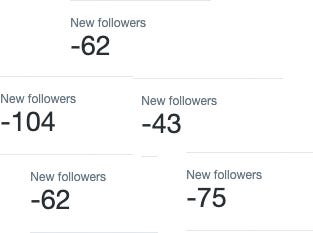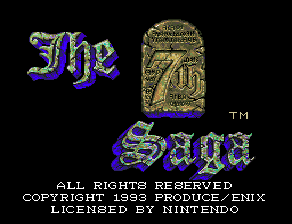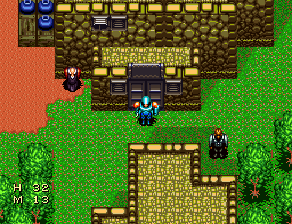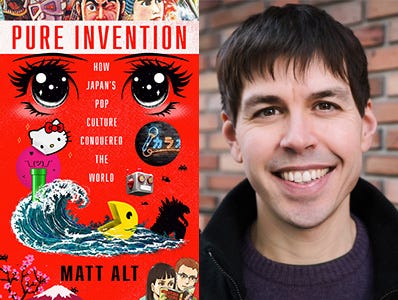Astrolabe 10: Several sagas, Japan's pop culture dominance, and the perils of going viral

Sudden Spotlight
I am feeling it these days, y’all.
The hours and energy, emotion and effort of creating content, writing articles, tweeting, promoting, streaming, making assets, editing, revising, reaching out, building a platform, draining everything I’ve got. The videos that get 10 views, the articles that don’t even get a comment, begging for likes, watching subscriber counts go down, wondering why you lost that follower, wondering why no one’s sharing.
Being a content creator often feels like screaming into a vast, uncaring void.
It’s exhausting at the best of times, and downright crippling after the hellfire of 2020.
But, what I’m talking about today is the opposite phenomenon. I’m going to tell you a story about the time when the void screamed back—enveloped me in its utter insanity—and the intense discomfort of suddenly having tens of millions of eyes one you all at once.
About a year ago, I tweeted this:
Tell me a story about yourself the sounds like a lie but is absolutely true.
— Aidan Moher for Best Fan Writer (@adribbleofink) 2:58 AM ∙ Jan 4, 2020
It blew UP. The subsequent days and weeks as it got more and more attention were a fun ride as I did radio interviews, mentioned on ESPN, and got RT’d by a whole slew of celebrities, politicians, and regular folk with some WILD stories.
From pro athletes:
My first year in the league, I played more games/mins in the playoffs than the regular season
— Clint Capela (@CapelaClint) 10:54 PM ∙ Jan 8, 2020
to myth busters:
I escaped from a car sinking upside down in water. Spent the night in a Tauntaun. I have been trained to drive tactically in high heels. Backwards. I escaped from Alcatraz, and have had several octopuses fall in love with me. I’ve been the the edge of space and dived with sharks.
— Adam Savage (@donttrythis) 4:49 PM ∙ Jan 13, 2020
to vice presidents:
In the summer of my sophomore year at Howard University, I interned with Senator Cranston of California.
— Vice President Kamala Harris (@VP) 2:04 AM ∙ Jan 11, 2020
I loved going to work—it felt like the epicenter of change, even as an intern sorting mail.
I now work in the exact Senate office where I once interned.
It started off innocently enough. I tweeted before bed, expecting a handful of replies from my friends in the morning—like any of my other tweets posing a question. But this was an avalanche. It was amazing hearing so many stories—but as the tweet started reaching millions of people, I got to a point where it was impossible to keep up with the attention. But more critically, I started to feel an anxiety about how to capitalize on the sudden spotlight.
As a creative professional, I'm ALWAYS thinking about how I can leverage attention into business. This was the biggest spotlight I'd ever had in my life. How could I turn that into success—or at the very least a foundation for future success?
The trouble was, I had no fucking clue.
This wasn’t a situation where you work your ass off and build up credibility and an audience slowly over time. This was literally a case of being thrust into the spotlight without any warning or script.
By early-February, I was meeting with a TV writer as we worked on a developing pitch package for a show based on the tweet. We were in discussion with a big TV production company. It was new territory for me, I didn’t have an agent or anyone to bounce business stuff off, and my anxiety was starting to build up. As I feared, the TV stuff eventually fell through, and so did my various freelance pitches to major publications where I wanted to talk about exactly this: What do you do when 30 million people are watching?
(For about a week, my major source of anxiety was that I might become the next Dan Levy and oh my god what the fuck my dad's not Eugene Levy how am I gonna do this do I gotta quit my job but I wanna writer a fantasy novel and what is TV how do I write who am I?)
I doubled my Twitter following in about a week. But ever since, it’s been in free fall. I can sit back and look at it objectively, recognizing that I’m still up about 80% of my followers compared to a year ago, but it’s emotionally taxing when you check your analytics and month after month it looks like this:

Social media followers are a poor way to measure your success, and they’re an AWFUL way to emotionally value your self worth. But, especially during an isolating year like 2020, it’s challenging to stay positive when you’re desperate for signs that people are listening when you’re speaking. We constantly seek validation of the time, energy, and soul we put into our work. And there are so few ways to accurately measure the results.
Ultimately what I realized, as a creative professional, is that my career, my life—my worth—aren't defined by any single moment or event. I took many lessons from that viral tweet that most of you forgot about by January 4th. I used those lessons to shore up my belief that self-worth is not a moment, but a countless series of building blocks that you assemble day-after-day, month-after month, year-after-year.
That silly tweet was my most visible creative success last year, but even after it failed to materialize riches, 2020 turned out to be my most successful professional year yet—and it had nothing to do with that tweet. I made major headway as a freelance games writer, got an agent, wrote a kickass book pitch, shored up a ton of important relationships, and met many great people who won't just help me in my career, but genuinely make my life better and happier.
That's success that can’t be measured by numbers.
Out & About
(Out & About is where I highlight my work around the web—some recent and some old favourites.)
Over on Input, where I previously wrote about a great homebrew app called 240p Test Suite, that helps retro gamers get the most out of their TVs, with a piece called “AI is about to transform the future (and past) of video games.” To help me tell this story of how fan restoration projects are beating huge corporations at their own game by using AI Machine Learning and community engagement, I spoke with the creator of Moguri Mod, Gaël Honorez, Marc Lauzon-Bragg, a retro game fan from Alberta, Canada, and Frank Cifaldi, Founder and Co-Director of the Video Game History Foundation.
I'm playing through Moguri Mod now, and what I've discovered isn't just a modern splash of paint on a classic game, but an experience that looks the way I remember the game looking when I first played it 20 years ago on my tube TV. Preservation means retaining knowledge in its original form, but projects like Moguri Mod make me wonder how we can approach the preservation of experiences — how a kid playing Final Fantasy IX can experience the same joy I did long after the last PlayStation has died, CRTs are nothing more than a memory, and technology has advanced toward Star Trek's utopia.
"Fans have the passion that drives them to dig and scrape for tiny incremental improvements wherever they can, to make a better experience," Cifaldi said. "Once it's commonly understood that fan restorations are the definitive versions of the games, I think the commercial industry may start catching up."
Read “AI is about to transform the future (and past) of video games” on Input
On another note, I just wanted to point you all to a wonderful new commission I had for a Twitter portrait!
All! I commissioned a super rad new avatar from @y2jenn. She was wonderful to work with, and well worth the rate of commission. Highly recommend working with her if you need an avatar, portrait for your D&D game, or anything similar.
— Aidan Moher for Best Fan Writer (@adribbleofink) 10:40 PM ∙ Jan 23, 2021
Artist Jenn Lee was absolutely wonderful to work with, nailed the style/tone I was hoping for, and exceeded all of my expectations. Highly recommend her to anyone looking for a personal caricature, D&D portrait, or gift for a family member/friend.
LTTP—The 7th Saga (Super Nintendo, 1993)
( LTTP stands for “Late to the Party” and is a regular column where I let Twitter decide which retro game I’ll play for an hour. Do your worst, Twitter!)
To kick off 2021, I decided to dig deep into the forgotten bowels of SNES Japanese RPGs and offer up some of the system’s most maligned games. And the winner was… The 7th Saga!

But, what if I told you The 7th Saga wasn’t as bad as its reputation would have you believe? What if I told you it did some pretty cool things, showed off the early SNES hardware in some fascinating ways, and had one of the most boppin’ item shop themes in the entire genre?
The 7th Saga is unpopular with some gamers due to its high difficulty level and required grinding. When I tried playing it as a kid, I couldn’t make it past the first enemy encounter, and returned the cart to my friend in a fit of pique. But, it turns out the brutal difficulty was introduced when the game was localized for North America, and the core game beneath that is actually pretty interesting. Maybe even fun.

One of The 7th Saga’s most unique features is its cast of seven main characters. At the outset, the player commits to a character—ranging from a standard Knight to an ice mage, all the way to a robot and alien—and then sets out on a quest given by the king to collect seven runes. Your chosen character defines your playthrough from a narrative standpoint, while also determining your combat style. As you complete the king’s quest, you’ll run into the other characters who also seek the runes. These encounters vary in tone, with some even leading to battle. It’s an interesting narrative structure for an early Super Nintendo game—bringing to mind Square Enix’s equally ambitious Live-a-Live, which released a year later in 1994, or Akitoshi Kawazu’s Romancing Saga 3.

Visually, The 7th Saga reminds me less of contemporaneous Super Nintendo JRPGs like Final Fantasy V or Illusion of Gaia, and more of similar-era games for the Genesis or PC, like Phantasy Star IV. One thing that’s totally in the SNES’s wheelhouse, though, is the impressive Mode-7 battle transition on the world maps. Unlike most games at the time, when the player enters a battle, The 7th Saga zooms into combat right on the map, making each battle background seamless and unique. Dungeons use a more tradition fade transition, but retain the expressive sprites and fun over-the-shoulder camera that makes battles visually interesting.
Also of note is the way the game straddles the line between on-screen enemies and random encounters. Instead of being able to see roaming monsters, the player has access to a radar in the top left of their screen which highlights the location of enemies, treasure chests, towns, and other similar points of interest. Enemies often feel unavoidable, as they move quickly toward the player, so it doesn’t feel much different than true random encounters, but it’s a fun aesthetic twist.

That’s small compensation, however, for the game’s biggest flaw: Its high difficulty and required grinding. As mentioned to earlier, The 7th Saga is infamous among North American players for its unforgiving and unnecessary challenge—an issue that surprises gamers in other regions.
“That challenge is taken to an extreme level in the US release of the game,” said Hardcore Gaming 101’s Chris Rasa. “The 7th Saga was a difficult game for its time with its variety of clues to find and relentless enemies to overcome, but for the US release, the game was made even more difficult. Enemies were made more powerful, and the game’s experience system was changed so that your own characters grow and learn new abilities at a much slower rate.”
Fortunately, enterprising fans have released rom hacks for The 7th Saga that aim at restoring the original difficulty level, taking the experience from frustrating to unique. I didn’t have much luck with the patches on my stream (it crashed a couple of times), but by all accounts they’re a great way to experience the much-maligned game. Is it enough to take it from skippable to classic? I doubt it, but it easily falls somewhere in between (which is unlikely to be said about the two games that lost my Twitter poll: Tecmo’s Secret of the Stars and Paladin’s Quest.)
Watch the Stream
The 7th Saga was released by Enix in 1993 for the Super Nintendo. It saw no future re-releases, so remains playable only on the original system. If you do track down a copy, RomHacking.net has a few worthwhile hacks that address the difficulty.
Recommended Reads

Pure Invention: How Japan's Pop Culture Conquered the World by Matt Alt
As you might know, I’m working on a book about the history of Japanese RPGs and how they skyrocketed to immense popularity in the west thanks to games like Final Fantasy VII. Part of this includes a lot of research, not just into the games of the era, but also Japan’s cultural impact and western proliferation. Matt Alt’s history of Japanese pop culture’s takeover of the west is a fascinating and thorough narrative told with an informed, casual voice that’s just a delight to read. From post-World War II toy Jeeps to Hello Kitty, karaoke and Evangelion, Alt covers a vast range of Japanese products, history, and creators, and makes it all eminently readable.
Quest Markers
(Quest Markers is a collection of the coolest stuff I’ve read around the web lately.)
- I wrote a book that I hope nobody reads (Charlie Jane Anders)
- Canadians in SF as Written by Non-Canadians (Tor.com)
- Former Workers Allege YouTube GameXplain Was Exploitative Workplace (Vice)
- The Disney Princess Dress Code, Explained (Behind the Seams)
- In Japan, You Can Visit the Totoro House. For Real. (Kotaku)
- Will There Ever Be an Openly Queer NHL Player? (The Walrus)
- My Little Pony Taught Me To Write Fluffy, Glittery Violence (Tor.com)
- People Are Reading So Much Fanfiction It's Crashing the Biggest Fanfic Website (Motherboard)
- Xbox: The Oral History of an American Video Game Empire (Bloomberg)
- The Best Way to Understand the Complexity of Games Is Playing Them With a Kid (Vice)
- Mithra-ndir: Gandalf and the Roman cult of Mithras (Ancient World Magazine)
- Donald Trump Is Out. Are We Ready to Talk About How He Got In? (The Atlantic)
End Step
That’s a wrap! 2020 was a challenging year for so many reasons, but I’ve got high hopes for 2021. I hope you all enjoy Matt Alt’s book, and I can’t wait to connect with y’all for the next edition of LTTP. As always, please reach out to say hi or give me feedback on Twitter: @adribbleofink.
Support
There are lots of ways to support Astrolabe and my other work. Check ‘em out!
- Patreon: http://patreon.com/adribbleofink
- Ko-fi: http://ko-fi.com/aidanmoher
- Paypal: http://paypal.me/AidanMoher
Keep In Touch
Enjoy Astrolabe? Want more SFF and retro gaming goodies? You can find me on Twitter and my website.
Credits
Astrolabe banner photo by Shot by Cerqueira on Unsplash

